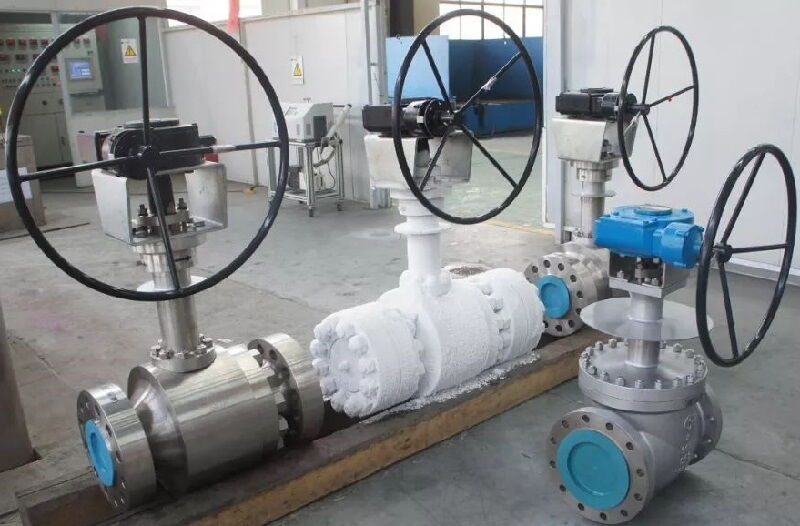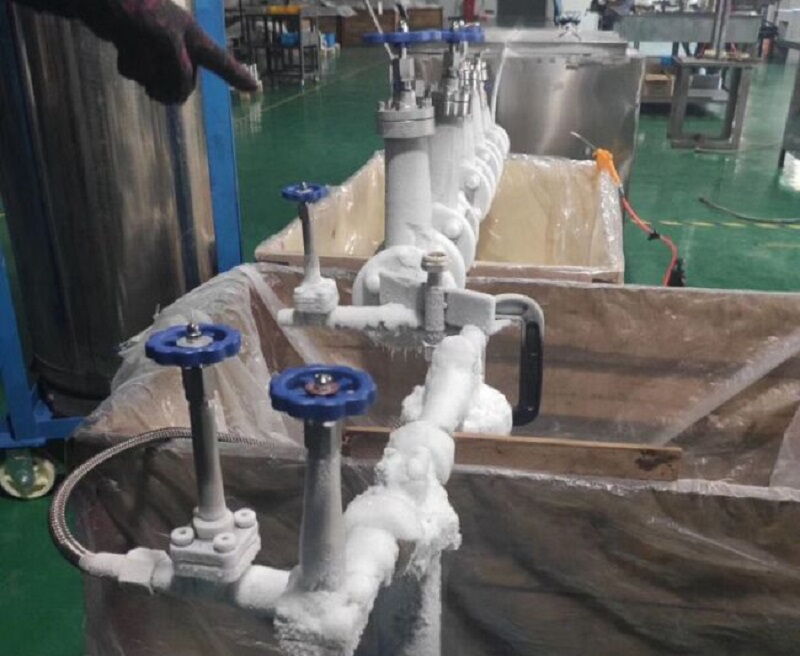Upon initial inspection, one will notice that cryogenic valves have a longer bonnet (or stem) than standard industrial valves. Why is it the case? This article will clarify the purpose of cryogenic valves' lengthy stems and how they contribute to their functionality.

Cryogenic valves are those made specifically to be utilized at very cold temperatures. Liquid oxygen, nitrogen, hydrogen, liquified natural gas, and other low-temperature fluids are precisely what these valves are designed to handle. Cryogenic valves are used in pipelines that transport these low-temperature fluids to regulate the flow.
Cryogenic valves are made to handle high-pressure gases and liquids in addition to low-temperature fluids. Among other industries, the petrochemical, food processing, and oil and gas sectors all make extensive use of these valves.
Cryogenic valves are typically made to transport and hold fluids at temperatures as low as -196°F and pressures as high as 52 bar. When working with cryogenic fluids, it becomes imperative to follow a few precautionary measures because many of them have the potential to explode when pressure and temperature circumstances change. Cryogenic valves are made with the utmost care because even a tiny flaw might result in irreversible harm.
- They are lightweight – makes it easier for them to transport fluids at low temperatures.
- Typically, cryogenic valves are constructed with minimal conductivity.
- These valves are designed to tuck into small areas.
- The assembly of cryogenic valves takes place in a lubricant-free clean room. This is due to the fact that at cryogenic temperatures, even minute amounts of undesirable material can be extremely dangerous.
Certain industrial valves are not appropriate to be constructed as cryogenic valves because they lack specific properties, making them unsuitable for use in cryogenic applications. Ball, butterfly, gate, and globe valves are a few types of industrial cryogenic valves that are frequently encountered.
- Cryogenic Ball Valves – These valves are the greatest choice for tight shut-off qualities and are one of the most popular solutions for cryogenic applications. These valves need to be utilized in areas with unrestricted flow, despite the fact that they are prone to wear and strain.
- Cryogenic Butterfly Valves – Cryogenic butterfly valves are a fantastic option for applications requiring frequent quick open and closure movements because they are short in length and simple to operate.
- Cryogenic Globe Valves – Cryogenic valves are linear motion valves with internal discs that provide long-lasting, reliable sealing. They are sturdy, however they are not advised for high-traffic locations.
- Cryogenic Relief Valves – These valves are made to stop the expansion of fluids inside pipelines from causing harm. The valve maintains the pressure condition by allowing steam to escape when the fluid pressure exceeds the safety limit.
- Cryogenic Gate Valves – The gate valve, like every other cryogenic valve, has an enlarged bonnet. A small pressure drop is produced by the valve even when it is fully open.

It is well known that a cryogenic valve's performance is greatly influenced by the material it is built of. This is due to the fact that at very low temperatures, normally functioning valves will become ineffective because the metal will become brittle. Additionally, in a cryogenic setting, standard valves will degrade the sealing quality.
on order to prevent cryogenic fluids from flowing or evaporating, cryogenic valves on pipelines are typically placed to the fully-closed position. The valve opens to allow fluid to flow when the pressure rises. By doing this, the pressure will drop and any potential vaporization issues will be avoided. When the desired pressure is reached, the valve immediately closes with a bubble-tight shutdown. This stops leaks from occurring.
To comprehend how a cryogenic valve functions, one must study its construction in great detail. An enlarged stem is one of the characteristics that set cryogenic valves apart from standard industrial valves. Many people are unaware of the reason behind the lengthy stem of cryogenic valves, yet understanding this is essential to understanding how a cryogenic valve works.
Cryogenic pipelines and valves handle a variety of flammable, explosive, or both fluids. Additionally, when the temperature rises, the fluids may swell to a hundred times their real size. This implies that even a small accident or leak might have severe effects. The fluids must be kept at the proper temperature and pressure in order to guarantee safe transmission.
This is when a cryogenic valve's expanded bonnet, also known as its stem, comes in handy. Because a cryogenic valve has a unique purpose under low-temperature conditions, its lengthy stem is invisible in an ordinary industrial valve. The lengthy stem of cryogenic valves is caused by three main factors:
- The longer stem makes sure the valve's packing is heated. The stuffing box will be impacted by low temperatures, which might cause freezing between the packing and stem and cause leaks. The low-temperature state is broken and the fluids evaporate when the packing leaks. The long stem is made to keep the stuffing box above 8°C in order to prevent all of these problems.
- The expanded stem provides a large area for the wrapping of materials that stop the loss of cold energy. The fluids inside the valve and the pipeline are kept in their original state by maintaining the cold temperature.
- Even in confined spaces, cryogenic valves may be easily positioned because to their lengthy bonnets. The pipes and valves used in these circumstances are mounted in a "cold box," and the box's wall may accommodate the long stem.

Several industries employ cryogenic valves due to their essential functionality. Cryogenic valves are frequently used in the oil and gas, petrochemical, chemical, food processing, and air separation industries, among other industries.
- LNG Plants and Terminals: Gases that have the potential to expand should be treated carefully. Liquefied natural gas (LNG) is easily transferred utilizing cryogenic pipes and valves.
- Food & Beverage Industry: Due to their suitability for transporting cold fluids, cryogenic valves are frequently used in this sector of the economy. These valves are used in freezers as well.
- Chemical and Petrochemical sector: The chemical sector handles a number of materials that require very low temperatures, including liquid nitrogen, oxygen, and ethylene. Cryogenic valves are an ideal option for this use. They are excellent for transporting various fluids, like LPG.
- Medical Industry: Cryogenic valves find extensive application in the medical field, where they are utilized to store vital gases such as liquid oxygen.
Cryogenic valves are distinctive in both their features and their functions; for the same reasons, they are used in many different sectors. One cannot select the appropriate kind of valve for any given function without understanding factors like the reason cryogenic valves have a lengthy stem. A consumer can make a more informed choice if they are aware of the different types of cryogenic valves and how they operate.
JONLOO is the ideal option if you're searching for a dependable producer of cryogenic valves. Being a top producer of industrial valves, we offer customized solutions and are experts in all kinds of industrial valves. Speak with us right now to choose the best valve options for your undertakings.
